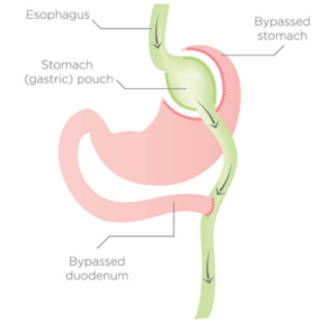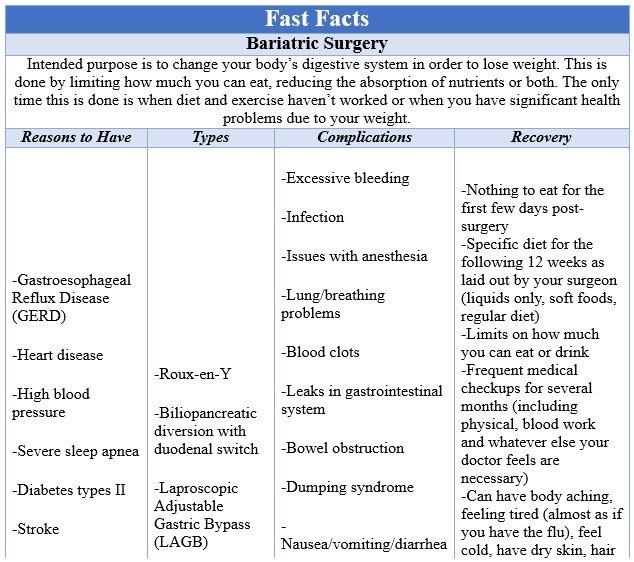How does it work?
You have probably heard the term “Gastric Bypass” or “Lap Band” before, but what do they mean? Are they the same thing? Is it a safe procedure? Who is eligible to have the procedure? Obviously, there are lots of questions and we’ve got the answers!
 Definition
Definition
The general term that encompasses Gastric Bypass and Lap Band is Bariatric Surgery. There are many different types and the intended purpose is to change your body’s digestive system in order to lose weight. They do this by limiting how much you can eat, reducing the absorption of nutrients or both. The only time this is done is when diet and exercise haven’t worked or when you have significant health problems due to your weight. Some of these health problems include Gastroesophageal Reflux Disease (GERD), heart disease, high blood pressure, severe sleep apnea, Diabetes types II, stroke, body mass index (BMI) > 40, or your BMI is 35 to 39.9 and you have some of the aforementioned serious weight-related health problems. There is a rigorous screening process that you must go through in order to qualify to have any of the surgeries. This usually includes blood work, physical exam, stopping smoking (if you smoke) and starting a physical activity program under the guidance of your doctor. You must make permanent changes to include eating healthy and physical exercise to ensure long term success of the operation. All bariatric surgery is considered major surgery and can pose serious risks and side effects. The general risks, as with any major surgery, are excessive bleeding, infection, issues with anesthesia, lung/breathing problems, blood clots, leaks in gastrointestinal system and death. Specific risks related to bariatric surgery include bowel obstruction, Dumping syndrome, nausea/vomiting/diarrhea, gallstones, hernia, blood sugar problems, malnutrition, ulcers and stomach perforation. The screening process is so strict due to all these and other possible complications.
Type
There are many different types of bariatric surgery, but the four most common are Roux-en-Y, Biliopancreatic diversion with duodenal switch, Laproscopic Adjustable Gastric Bypass (LAGB) and Sleeve gastrectomy. Roux-en-Y is the most common and is a non-reversible procedure. The surgeon cuts across the top of your stomach and makes a small pouch that is detached from the rest of your stomach. This pouch is connected to the middle of your small intestines. The pouch holds 1oz of food versus the 3 pints that a normal stomach can hold. By doing this procedure, the size of your stomach is decreased causing the amount of food you can ingest in one sitting to decrease dramatically. It also decreases the absorption of nutrients by eliminating a good portion of your stomach and upper half of small intestines from the digestive process. Biliopancreatic diversion with duodenal switch is complex and requires multiple procedures. The end result is that 80% of your stomach is removed. The pyloric valve (typically connects stomach to beginning of the small intestines, or duodenum) and duodenum remain. They are connected to the end portion of the intestines. The procedure is very effective because it limits how much you can eat and the absorption of nutrients. However, there is an increased risk of malnutrition and vitamin deficiencies because of the amount of the digestive tract that is bypassed. Due to this increased risk, this procedure is usually only done for people who have a BMI > 50. Laproscopic Adjustable Gastric Banding (LAGB) is when an inflatable band is placed around the upper portion of your stomach, effectively separating it into two parts with a small channel connecting them. The upper part limits the amount of food you can eat. The band can be tightened or loosened in order to get the desired amount of weight loss. Some people do not find this to be as effective as other types of bariatric surgery. Sleeve gastrectomy is a new type of surgery that has a multistep process. This procedure is actually the first part of the biliopancreatic diversion with duodenal switch procedure, but without the diversion portion. Sometimes, this is all that a person needs to have weight loss. The procedure involves restructuring the shape of your stomach to be shaped like a tube thus restricting your calorie absorption. Which type is best for you? That depends on a number of factors, such as your BMI, eating habits, health problems, any previous surgeries and the risk of the procedure. Only your doctor can help determine which procedure you should have after thoroughly evaluating all of this information.
Prevention
The recovery process for most bariatric surgeries is overall the same. Typically involves you not having any food or drinks for a day or two after in order to let your digestive tract heal. You will be on a specific diet for the following 12 weeks as laid out by your surgeon prior to surgery. Usually involves liquids only, followed by soft foods and then regular diet. You may have limits on how much you can eat or drink. You will need frequent medical checkups for the next several months in order to make sure that everything is healing and your body is getting enough nutrients. As part of these exams, you will have a physical, blood work and whatever else your doctor feels are necessary. Initially, you may have body aching, feeling tired (almost as if you have the flu), feel cold, have dry skin, hair thinning/loss and mood changes. All of these are the result of your body reacting to the rapid weight loss. The amount of weight loss depends on the type of surgery and how effective your changes to lifestyle habits are. For those who are diligent with their changes and follow up care, they may lose up to half or more of their excess weight within two years. Also, you can reduce the affect of health conditions and increase your ability to function on a daily basis. Unfortunately, the procedures don’t always work. Sometimes, something goes wrong during the procedure or you don’t follow the lifestyle changes closely enough. This is why it is essential to keep all of your follow up appointments and to let your doctor know if you aren’t losing weight or experiencing any complications. If you don’t follow the lifestyle changes, you could actually gain weight (even if the procedure was a success).
Bariatric surgery is an expensive and major surgery. Having it done can be a life-changing event, but it is not for everyone. If you are considering having bariatric surgery, please consult with your doctor. If you would like more information, please visit National Institute of Health’s bariatric surgery page at https://www.niddk.nih.gov/health-information/weight-management/bariatric-surgery/types